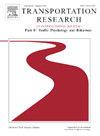针对三级自动驾驶中分心驾驶员的增强现实人机界面:对接管性能和安全性的影响
IF 3.5
2区 工程技术
Q1 PSYCHOLOGY, APPLIED
Transportation Research Part F-Traffic Psychology and Behaviour
Pub Date : 2024-10-19
DOI:10.1016/j.trf.2024.10.002
引用次数: 0
摘要
随着自动化水平的提高,驾驶员可能会转移对道路环境的注意力,从事与驾驶无关的工作,从而降低对情况的感知能力,这可能会在人工接管请求的情况下影响安全。在这项研究中,我们在虚拟环境中模拟了一种增强现实情景适应人机界面(HMI)。该人机界面旨在提高接管质量,方法是在三级自动驾驶情况下,在分心驾驶员提出接管请求后,加强对情况认知的重建。为此,人机界面显示了驾驶员应注意的重要元素的突出视觉提示(自下而上的过程)。此外,还提供了用户手册中的说明,详细介绍了如何通过展示理想的接管顺序(自上而下的过程)来重新获得情况感知,这对于使用人机界面是必不可少的。为此,我们使用中等逼真度的静态驾驶模拟器进行了一项实验,35 名参与者按照三个被试之间的条件进行了分配:"对照组--不带人机界面的基本用户手册"、"不带人机界面的以理想接管顺序为重点的用户手册 "和 "带人机界面的以理想接管顺序为重点的用户手册"。结果显示,增强现实人机交互界面提高了在交通繁忙路段变道和紧急制动时接管的安全性,具有更好的交通插入性和更长的碰撞时间。只收到理想接管顺序用户手册(自上而下的过程)的参与者在接管情况下对驾驶环境的视觉探索较少,这可能会导致安全问题。这些结果与现有文献以及在更简单的设备(如平视显示器)中实现这种人机界面的可能性进行了讨论,以提供更广泛的应用。本文章由计算机程序翻译,如有差异,请以英文原文为准。
Augmented reality HMI for distracted drivers in a level 3 automation: Effects on takeover performance and safety
With an increased level of automation, drivers can divert attention from the road environment and engage in non-driving-related tasks, thus reducing situation awareness, which could impact safety in cases of manual takeover requests. In this research, an augmented reality situation-adaptive human–machine interface (HMI) was simulated in a virtual environment. The HMI aimed to improve the quality of takeovers by boosting the reconstruction of situation awareness in distracted drivers following a takeover request in a Level 3 automated driving situation. To this end, the HMI displayed salient visual cues (bottom-up process) for important elements that drivers should pay attention to. Instructions from a user manual were also provided, detailing how to regain situation awareness by presenting the ideal takeover sequence (top-down process), which was necessary for the use of the HMI. For this purpose, an experiment was conducted using a medium-fidelity static driving simulator with a sample of 35 participants distributed according to three between-subjects conditions: “control – basic user manual without HMI,” “ideal takeover sequence focused user manual without HMI,” and “ideal takeover sequence focused user manual with HMI.” According to the results, the augmented reality HMI improved safety in takeovers involving lane changes in heavy traffic and emergency braking, with better traffic insertion and higher time to collision. Participants who only received the user manual dedicated to the ideal takeover sequence (top-down process) exhibited less visual exploration of the driving environment in the takeover situations, which could lead to safety issues. These results are discussed regarding existing literature and possible implementations of such an HMI in a simpler device, such as a head-up display, for provide wider application.
求助全文
通过发布文献求助,成功后即可免费获取论文全文。
去求助
来源期刊
CiteScore
7.60
自引率
14.60%
发文量
239
审稿时长
71 days
期刊介绍:
Transportation Research Part F: Traffic Psychology and Behaviour focuses on the behavioural and psychological aspects of traffic and transport. The aim of the journal is to enhance theory development, improve the quality of empirical studies and to stimulate the application of research findings in practice. TRF provides a focus and a means of communication for the considerable amount of research activities that are now being carried out in this field. The journal provides a forum for transportation researchers, psychologists, ergonomists, engineers and policy-makers with an interest in traffic and transport psychology.

 求助内容:
求助内容: 应助结果提醒方式:
应助结果提醒方式:


